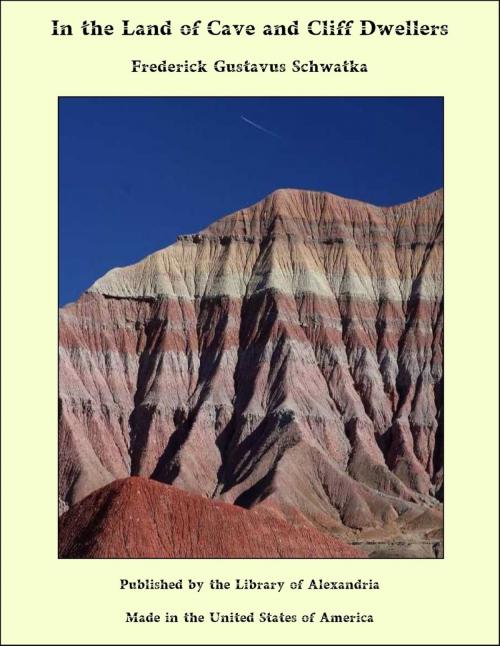In the Land of Cave and Cliff Dwellers
Nonfiction, Religion & Spirituality, New Age, History, Fiction & Literature| Author: | Frederick Gustavus Schwatka | ISBN: | 9781465607836 |
| Publisher: | Library of Alexandria | Publication: | March 8, 2015 |
| Imprint: | Language: | English |
| Author: | Frederick Gustavus Schwatka |
| ISBN: | 9781465607836 |
| Publisher: | Library of Alexandria |
| Publication: | March 8, 2015 |
| Imprint: | |
| Language: | English |
The first chapter describing an expedition is liable to be prosaic to the point of dullness. It is full of promises that are expected to be realized, while as yet nothing has been done. Not one-tenth of these may formulate, and yet the expedition may be a success in unexpected results; for in no undertaking is there so much uncertainty as in travel through little known countries. Then, again, the writer is likely to consider himself called upon to give a lengthy description of the party in the preliminary letter, and, as I have often seen, even descend to an enumeration of the qualities of the cook or the color of the mules. The next night the cook may desert and the mules may run away, so that others must be procured, and therefore they are of no more interest to the reader than any other of the millions of cooks or mules that would make any writer wealthy if he could find a publisher who would print his description of them. I intend to break away from that stereotyped formula in this first chapter and briefly state that I was in the field of Northern Mexico, hoping to obtain new and interesting matter beyond the everlasting descriptions that are now pumped up for the public by versatile writers along the beaten lines of tourist travel, as determined by the railroads, and, occasionally, the diligence lines. I had a good outfit of wagons, horses, mules, and last, but not least, men for that purpose. Each and every member of the expedition will be heard from when anything has been done by them, and not before. When the mule Dulce kicks a hectare of daylight through the cook for spilling hot grease on his heels I will give a description of Dulce and an obituary notice of the cook; but until then they will remain out of the account. We crossed the boundary south of Deming early in March, 1889, and entered Mexican territory, where our travels can be said to have begun. If one will take the pains to look at a map of this portion of Mexico he will see that it projects into the United States some distance beyond the average northern boundary, the Rio Grande being to our east, and an "offset," as we would say in surveying, being to our west, this "offset" running north and south. This flat peninsula projecting into our own country can be better understood by visiting it and comparing it with the surrounding land of the United States, coupled with a history of the country. Roughly speaking, the Mexican-United States boundary, as settled by the Mexican War, followed the line of the Southern Pacific Railway as now constructed, and the so-called Gadsden purchase from Mexico of a few years later fixed the boundary as we now see it, giving us a narrow, sabulous strip of Mexican territory, but a definite boundary, easily established by surveys.
The first chapter describing an expedition is liable to be prosaic to the point of dullness. It is full of promises that are expected to be realized, while as yet nothing has been done. Not one-tenth of these may formulate, and yet the expedition may be a success in unexpected results; for in no undertaking is there so much uncertainty as in travel through little known countries. Then, again, the writer is likely to consider himself called upon to give a lengthy description of the party in the preliminary letter, and, as I have often seen, even descend to an enumeration of the qualities of the cook or the color of the mules. The next night the cook may desert and the mules may run away, so that others must be procured, and therefore they are of no more interest to the reader than any other of the millions of cooks or mules that would make any writer wealthy if he could find a publisher who would print his description of them. I intend to break away from that stereotyped formula in this first chapter and briefly state that I was in the field of Northern Mexico, hoping to obtain new and interesting matter beyond the everlasting descriptions that are now pumped up for the public by versatile writers along the beaten lines of tourist travel, as determined by the railroads, and, occasionally, the diligence lines. I had a good outfit of wagons, horses, mules, and last, but not least, men for that purpose. Each and every member of the expedition will be heard from when anything has been done by them, and not before. When the mule Dulce kicks a hectare of daylight through the cook for spilling hot grease on his heels I will give a description of Dulce and an obituary notice of the cook; but until then they will remain out of the account. We crossed the boundary south of Deming early in March, 1889, and entered Mexican territory, where our travels can be said to have begun. If one will take the pains to look at a map of this portion of Mexico he will see that it projects into the United States some distance beyond the average northern boundary, the Rio Grande being to our east, and an "offset," as we would say in surveying, being to our west, this "offset" running north and south. This flat peninsula projecting into our own country can be better understood by visiting it and comparing it with the surrounding land of the United States, coupled with a history of the country. Roughly speaking, the Mexican-United States boundary, as settled by the Mexican War, followed the line of the Southern Pacific Railway as now constructed, and the so-called Gadsden purchase from Mexico of a few years later fixed the boundary as we now see it, giving us a narrow, sabulous strip of Mexican territory, but a definite boundary, easily established by surveys.















